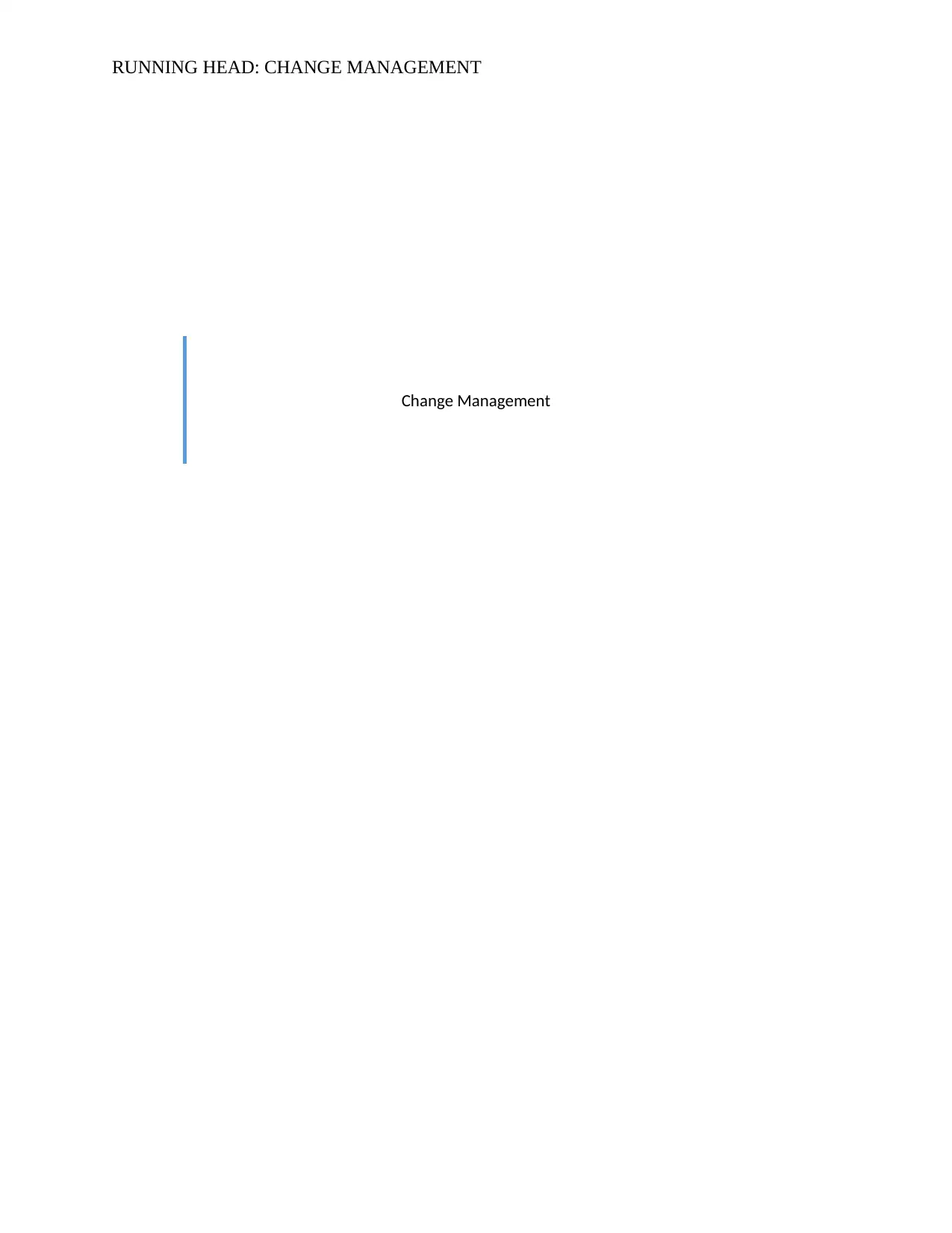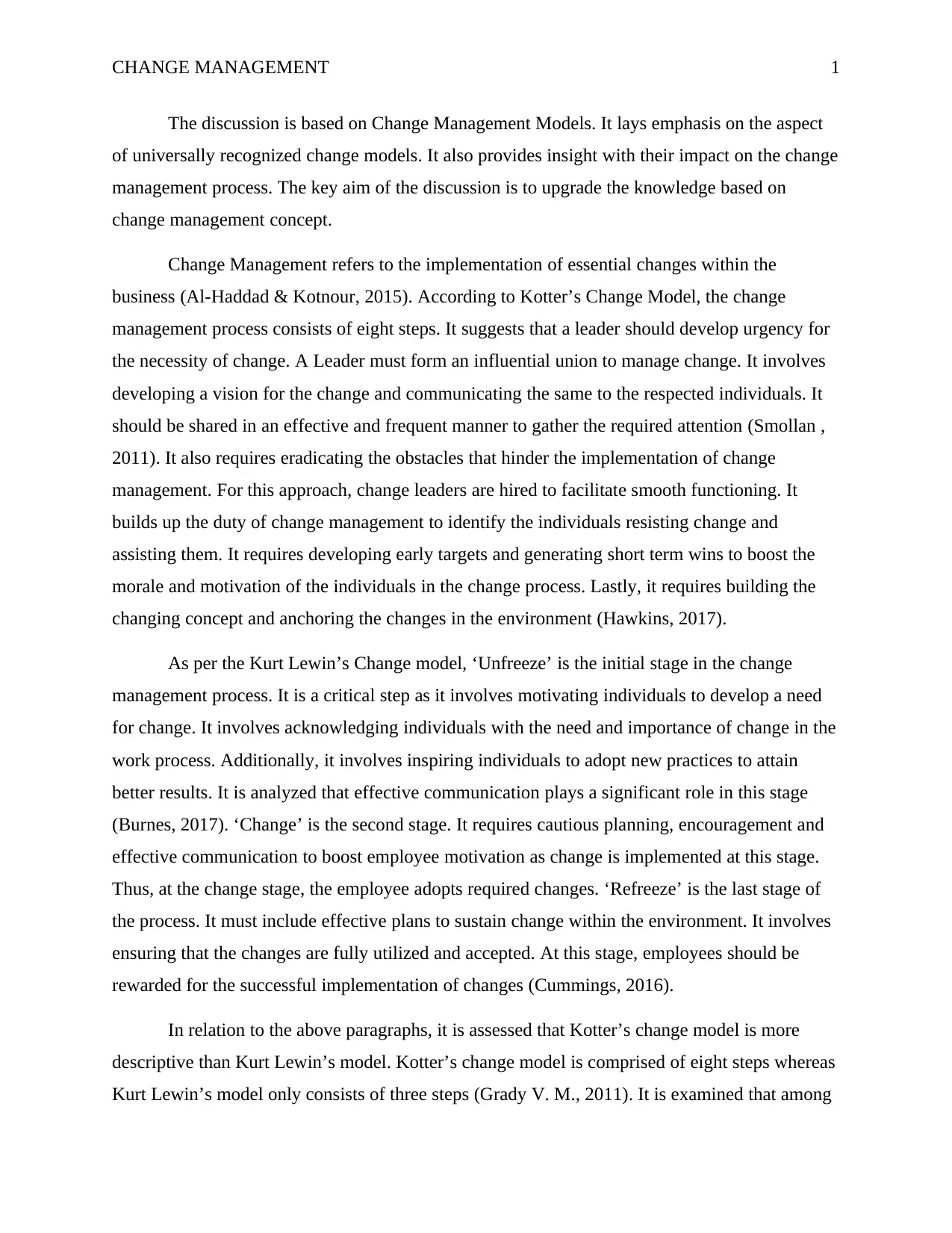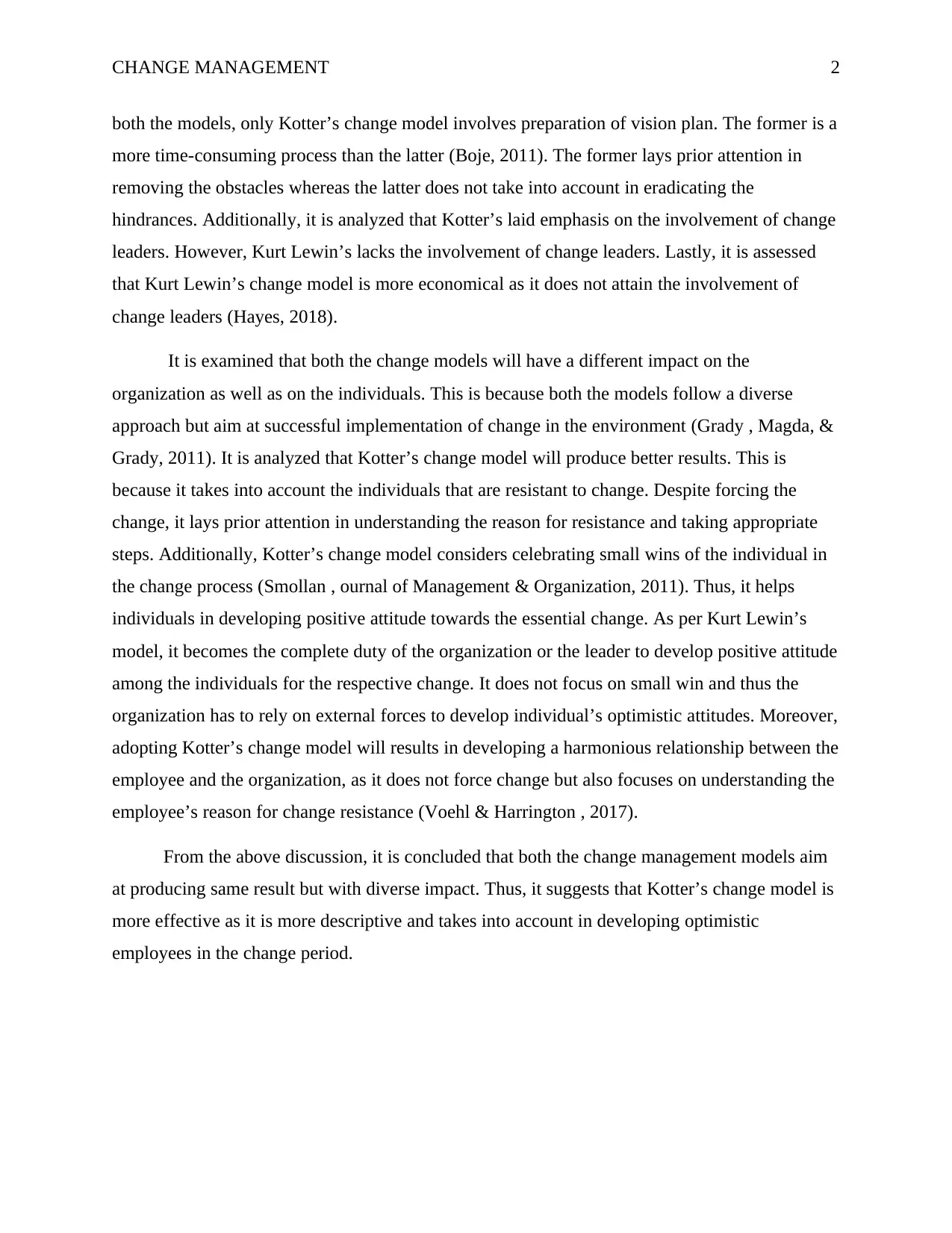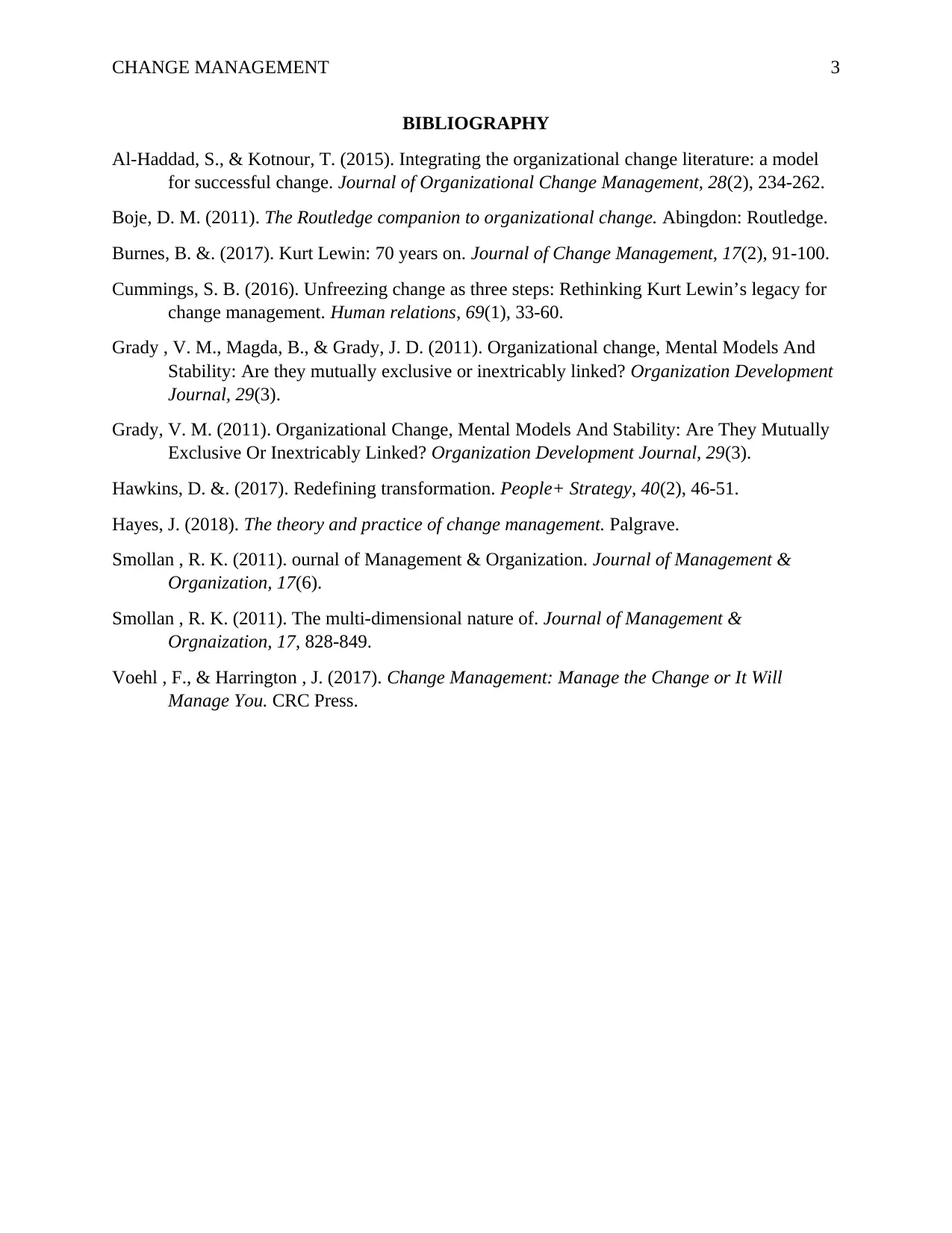A Comparative Analysis of Change Management Models: Kotter and Lewin
VerifiedAdded on 2022/09/14
|4
|1234
|13
Essay
AI Summary
This essay delves into the realm of change management, focusing on two prominent models: Kotter's and Lewin's. The discussion begins by defining change management and highlighting the importance of universally recognized models. It then provides a detailed examination of Kotter's eight-step model, emphasizing the need for creating urgency, forming a powerful coalition, developing a vision, communicating effectively, removing obstacles, generating short-term wins, and anchoring changes. The essay contrasts this with Lewin's three-stage model (Unfreeze, Change, Refreeze), analyzing the impact of each model on organizational change implementation and resistance. It highlights the descriptive nature of Kotter's model, its emphasis on vision planning, and its attention to mitigating resistance, concluding that while both models aim for successful change, Kotter's approach, with its comprehensive steps and focus on employee engagement, is more effective in fostering positive attitudes and harmonious relationships within the organization. The essay also includes a comprehensive bibliography of the cited sources.

RUNNING HEAD: CHANGE MANAGEMENT
Change Management
Change Management
Paraphrase This Document
Need a fresh take? Get an instant paraphrase of this document with our AI Paraphraser

CHANGE MANAGEMENT 1
The discussion is based on Change Management Models. It lays emphasis on the aspect
of universally recognized change models. It also provides insight with their impact on the change
management process. The key aim of the discussion is to upgrade the knowledge based on
change management concept.
Change Management refers to the implementation of essential changes within the
business (Al-Haddad & Kotnour, 2015). According to Kotter’s Change Model, the change
management process consists of eight steps. It suggests that a leader should develop urgency for
the necessity of change. A Leader must form an influential union to manage change. It involves
developing a vision for the change and communicating the same to the respected individuals. It
should be shared in an effective and frequent manner to gather the required attention (Smollan ,
2011). It also requires eradicating the obstacles that hinder the implementation of change
management. For this approach, change leaders are hired to facilitate smooth functioning. It
builds up the duty of change management to identify the individuals resisting change and
assisting them. It requires developing early targets and generating short term wins to boost the
morale and motivation of the individuals in the change process. Lastly, it requires building the
changing concept and anchoring the changes in the environment (Hawkins, 2017).
As per the Kurt Lewin’s Change model, ‘Unfreeze’ is the initial stage in the change
management process. It is a critical step as it involves motivating individuals to develop a need
for change. It involves acknowledging individuals with the need and importance of change in the
work process. Additionally, it involves inspiring individuals to adopt new practices to attain
better results. It is analyzed that effective communication plays a significant role in this stage
(Burnes, 2017). ‘Change’ is the second stage. It requires cautious planning, encouragement and
effective communication to boost employee motivation as change is implemented at this stage.
Thus, at the change stage, the employee adopts required changes. ‘Refreeze’ is the last stage of
the process. It must include effective plans to sustain change within the environment. It involves
ensuring that the changes are fully utilized and accepted. At this stage, employees should be
rewarded for the successful implementation of changes (Cummings, 2016).
In relation to the above paragraphs, it is assessed that Kotter’s change model is more
descriptive than Kurt Lewin’s model. Kotter’s change model is comprised of eight steps whereas
Kurt Lewin’s model only consists of three steps (Grady V. M., 2011). It is examined that among
The discussion is based on Change Management Models. It lays emphasis on the aspect
of universally recognized change models. It also provides insight with their impact on the change
management process. The key aim of the discussion is to upgrade the knowledge based on
change management concept.
Change Management refers to the implementation of essential changes within the
business (Al-Haddad & Kotnour, 2015). According to Kotter’s Change Model, the change
management process consists of eight steps. It suggests that a leader should develop urgency for
the necessity of change. A Leader must form an influential union to manage change. It involves
developing a vision for the change and communicating the same to the respected individuals. It
should be shared in an effective and frequent manner to gather the required attention (Smollan ,
2011). It also requires eradicating the obstacles that hinder the implementation of change
management. For this approach, change leaders are hired to facilitate smooth functioning. It
builds up the duty of change management to identify the individuals resisting change and
assisting them. It requires developing early targets and generating short term wins to boost the
morale and motivation of the individuals in the change process. Lastly, it requires building the
changing concept and anchoring the changes in the environment (Hawkins, 2017).
As per the Kurt Lewin’s Change model, ‘Unfreeze’ is the initial stage in the change
management process. It is a critical step as it involves motivating individuals to develop a need
for change. It involves acknowledging individuals with the need and importance of change in the
work process. Additionally, it involves inspiring individuals to adopt new practices to attain
better results. It is analyzed that effective communication plays a significant role in this stage
(Burnes, 2017). ‘Change’ is the second stage. It requires cautious planning, encouragement and
effective communication to boost employee motivation as change is implemented at this stage.
Thus, at the change stage, the employee adopts required changes. ‘Refreeze’ is the last stage of
the process. It must include effective plans to sustain change within the environment. It involves
ensuring that the changes are fully utilized and accepted. At this stage, employees should be
rewarded for the successful implementation of changes (Cummings, 2016).
In relation to the above paragraphs, it is assessed that Kotter’s change model is more
descriptive than Kurt Lewin’s model. Kotter’s change model is comprised of eight steps whereas
Kurt Lewin’s model only consists of three steps (Grady V. M., 2011). It is examined that among

CHANGE MANAGEMENT 2
both the models, only Kotter’s change model involves preparation of vision plan. The former is a
more time-consuming process than the latter (Boje, 2011). The former lays prior attention in
removing the obstacles whereas the latter does not take into account in eradicating the
hindrances. Additionally, it is analyzed that Kotter’s laid emphasis on the involvement of change
leaders. However, Kurt Lewin’s lacks the involvement of change leaders. Lastly, it is assessed
that Kurt Lewin’s change model is more economical as it does not attain the involvement of
change leaders (Hayes, 2018).
It is examined that both the change models will have a different impact on the
organization as well as on the individuals. This is because both the models follow a diverse
approach but aim at successful implementation of change in the environment (Grady , Magda, &
Grady, 2011). It is analyzed that Kotter’s change model will produce better results. This is
because it takes into account the individuals that are resistant to change. Despite forcing the
change, it lays prior attention in understanding the reason for resistance and taking appropriate
steps. Additionally, Kotter’s change model considers celebrating small wins of the individual in
the change process (Smollan , ournal of Management & Organization, 2011). Thus, it helps
individuals in developing positive attitude towards the essential change. As per Kurt Lewin’s
model, it becomes the complete duty of the organization or the leader to develop positive attitude
among the individuals for the respective change. It does not focus on small win and thus the
organization has to rely on external forces to develop individual’s optimistic attitudes. Moreover,
adopting Kotter’s change model will results in developing a harmonious relationship between the
employee and the organization, as it does not force change but also focuses on understanding the
employee’s reason for change resistance (Voehl & Harrington , 2017).
From the above discussion, it is concluded that both the change management models aim
at producing same result but with diverse impact. Thus, it suggests that Kotter’s change model is
more effective as it is more descriptive and takes into account in developing optimistic
employees in the change period.
both the models, only Kotter’s change model involves preparation of vision plan. The former is a
more time-consuming process than the latter (Boje, 2011). The former lays prior attention in
removing the obstacles whereas the latter does not take into account in eradicating the
hindrances. Additionally, it is analyzed that Kotter’s laid emphasis on the involvement of change
leaders. However, Kurt Lewin’s lacks the involvement of change leaders. Lastly, it is assessed
that Kurt Lewin’s change model is more economical as it does not attain the involvement of
change leaders (Hayes, 2018).
It is examined that both the change models will have a different impact on the
organization as well as on the individuals. This is because both the models follow a diverse
approach but aim at successful implementation of change in the environment (Grady , Magda, &
Grady, 2011). It is analyzed that Kotter’s change model will produce better results. This is
because it takes into account the individuals that are resistant to change. Despite forcing the
change, it lays prior attention in understanding the reason for resistance and taking appropriate
steps. Additionally, Kotter’s change model considers celebrating small wins of the individual in
the change process (Smollan , ournal of Management & Organization, 2011). Thus, it helps
individuals in developing positive attitude towards the essential change. As per Kurt Lewin’s
model, it becomes the complete duty of the organization or the leader to develop positive attitude
among the individuals for the respective change. It does not focus on small win and thus the
organization has to rely on external forces to develop individual’s optimistic attitudes. Moreover,
adopting Kotter’s change model will results in developing a harmonious relationship between the
employee and the organization, as it does not force change but also focuses on understanding the
employee’s reason for change resistance (Voehl & Harrington , 2017).
From the above discussion, it is concluded that both the change management models aim
at producing same result but with diverse impact. Thus, it suggests that Kotter’s change model is
more effective as it is more descriptive and takes into account in developing optimistic
employees in the change period.
⊘ This is a preview!⊘
Do you want full access?
Subscribe today to unlock all pages.

Trusted by 1+ million students worldwide

CHANGE MANAGEMENT 3
BIBLIOGRAPHY
Al-Haddad, S., & Kotnour, T. (2015). Integrating the organizational change literature: a model
for successful change. Journal of Organizational Change Management, 28(2), 234-262.
Boje, D. M. (2011). The Routledge companion to organizational change. Abingdon: Routledge.
Burnes, B. &. (2017). Kurt Lewin: 70 years on. Journal of Change Management, 17(2), 91-100.
Cummings, S. B. (2016). Unfreezing change as three steps: Rethinking Kurt Lewin’s legacy for
change management. Human relations, 69(1), 33-60.
Grady , V. M., Magda, B., & Grady, J. D. (2011). Organizational change, Mental Models And
Stability: Are they mutually exclusive or inextricably linked? Organization Development
Journal, 29(3).
Grady, V. M. (2011). Organizational Change, Mental Models And Stability: Are They Mutually
Exclusive Or Inextricably Linked? Organization Development Journal, 29(3).
Hawkins, D. &. (2017). Redefining transformation. People+ Strategy, 40(2), 46-51.
Hayes, J. (2018). The theory and practice of change management. Palgrave.
Smollan , R. K. (2011). ournal of Management & Organization. Journal of Management &
Organization, 17(6).
Smollan , R. K. (2011). The multi-dimensional nature of. Journal of Management &
Orgnaization, 17, 828-849.
Voehl , F., & Harrington , J. (2017). Change Management: Manage the Change or It Will
Manage You. CRC Press.
BIBLIOGRAPHY
Al-Haddad, S., & Kotnour, T. (2015). Integrating the organizational change literature: a model
for successful change. Journal of Organizational Change Management, 28(2), 234-262.
Boje, D. M. (2011). The Routledge companion to organizational change. Abingdon: Routledge.
Burnes, B. &. (2017). Kurt Lewin: 70 years on. Journal of Change Management, 17(2), 91-100.
Cummings, S. B. (2016). Unfreezing change as three steps: Rethinking Kurt Lewin’s legacy for
change management. Human relations, 69(1), 33-60.
Grady , V. M., Magda, B., & Grady, J. D. (2011). Organizational change, Mental Models And
Stability: Are they mutually exclusive or inextricably linked? Organization Development
Journal, 29(3).
Grady, V. M. (2011). Organizational Change, Mental Models And Stability: Are They Mutually
Exclusive Or Inextricably Linked? Organization Development Journal, 29(3).
Hawkins, D. &. (2017). Redefining transformation. People+ Strategy, 40(2), 46-51.
Hayes, J. (2018). The theory and practice of change management. Palgrave.
Smollan , R. K. (2011). ournal of Management & Organization. Journal of Management &
Organization, 17(6).
Smollan , R. K. (2011). The multi-dimensional nature of. Journal of Management &
Orgnaization, 17, 828-849.
Voehl , F., & Harrington , J. (2017). Change Management: Manage the Change or It Will
Manage You. CRC Press.
1 out of 4
Related Documents
Your All-in-One AI-Powered Toolkit for Academic Success.
+13062052269
info@desklib.com
Available 24*7 on WhatsApp / Email
![[object Object]](/_next/static/media/star-bottom.7253800d.svg)
Unlock your academic potential
Copyright © 2020–2025 A2Z Services. All Rights Reserved. Developed and managed by ZUCOL.



